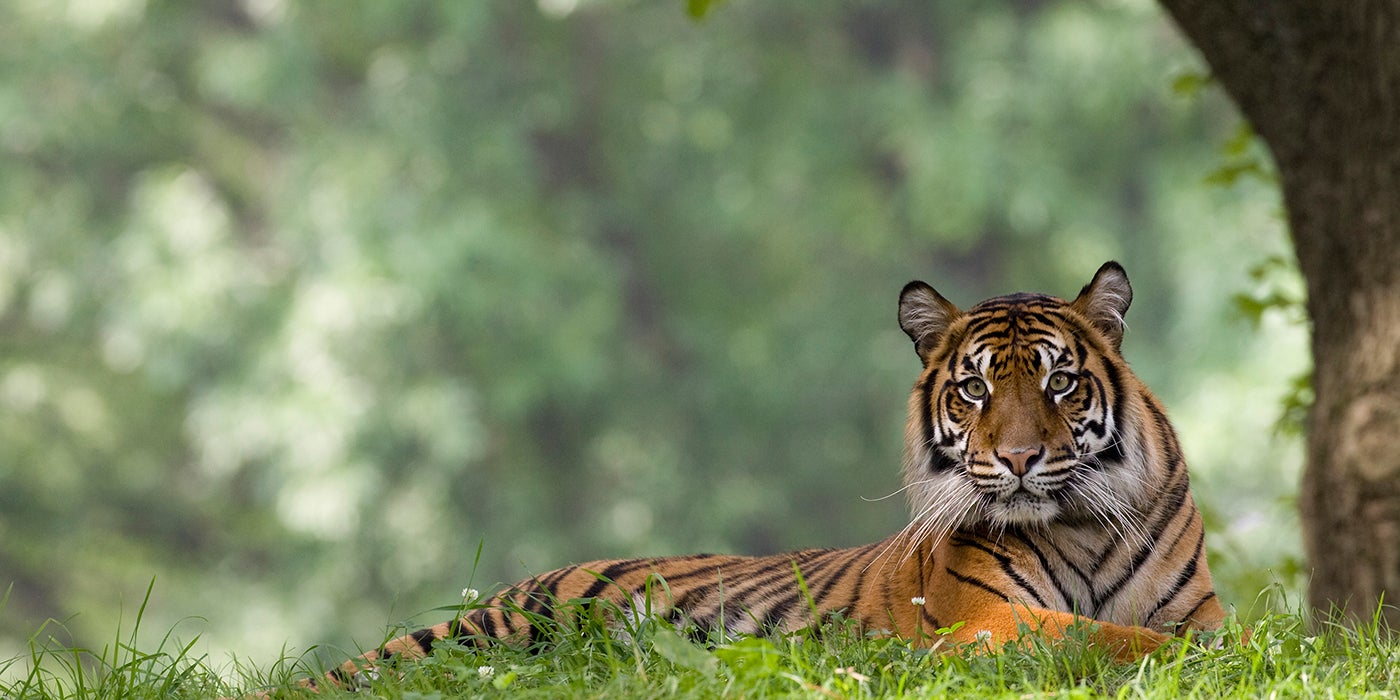Just How Big are Tigers? What Does Tiger Poop Look Like? And More Tiger Facts

July 29 is International Tiger Day, so sink your teeth into these fun facts about big cats.

How big are tigers?
Tigers are the largest cat species in the world. Amur tigers (sometimes called Siberian tigers) are the biggest tigers, with males weighing up to 660 pounds and measuring up to 10 feet long from nose to tip of the tail. Sumatran tigers are the smallest of the tiger subspecies, maxing out at about 310 pounds and 8 feet.
How do zookeepers safely work with tigers?
Animal keepers at the Smithsonian’s National Zoo never enter an enclosure with a tiger, because tigers are just too big and potentially dangerous. Keepers rely on many tools to work safely with these big cats, such as fences and locks. They also constantly have colleagues double check their work, including making sure locks are secure and confirming the location of cats with two sets of eyes.
They also utilize a type of training, called operant conditioning, to safely work with these huge felines. Tigers learn to allow keepers look at their teeth, eyes, bellies, and the bottom of their feet. Keepers use positive reinforcement to teach them to lay down, stand up and put their paws on the mesh fence — all by following a target, such as a pole with a red ball at the end. When a tiger completes a task, it gets a tasty reward. Training sessions are always voluntary and allow tigers to participate in their own care.
Do tigers like snow?
How far can a tiger jump?
A tiger can jump roughly 18-20 feet! Although other large felines, such as pumas and leopards, can also take big leaps, the tiger’s impressive size makes its long jumps even more astonishing.
Do tigers make good pets?
No. Tigers are wild animals and should never be kept as pets. Tiger cubs may look cute and cuddly, but they grow into very large, powerful carnivores with sharp teeth and claws that make them incredibly destructive and potentially deadly. Tigers also require specialized diets and healthcare that the average person simply can’t provide. In many states, it’s illegal to own tigers and other exotic animals.
Do tigers purr?
Like other big cats, tigers can’t purr, but they sure can roar. Tigers also bellow, grunt and chuff, and they use scent marking as another form of communication.

What does tiger poop look like?
Big! It looks a lot like domestic cat poop — just 100 times bigger. It’s particularly smelly, shaped like a segmented tube, and usually a dark brown or grayish color. More curious might be the aroma of a tiger’s urine, which some people think smells like buttered popcorn.
Did you know that poop can tell a keen animal keeper a lot about an animal’s health? Keepers are trained to notice any problems with the amount or consistency of these smelly gifts. They can also track a female tiger’s breeding cycle by studying its poop. Keepers collect a sample and send it to the Zoo’s endocrine lab, where scientists can measure the hormone levels and determine if the tiger is ready to breed.
Do tigers live in groups?
Tigers usually live alone, except when mating or raising young cubs. Tiger cubs live with their mothers until they are 2-3 years old and can hunt on their own. Then, they head off to find their own territory. Females typically choose territories near their mothers, while males tend to journey farther from home.

Are tigers endangered?
Yes, there were once nine subspecies of tigers in Asia. Three (Balinese, Caspian and Javan) have gone extinct. Six subspecies of tigers survive today. The Amur, Bengal and Indochinese tigers are considered endangered, and the Malayan, South China and Sumatran tigers are considered critically endangered. They are threatened by habitat loss, as cities and farmland expand into their territories, and are often killed when they come into conflict with humans. These big cats are also illegally poached for use in traditional medicines.
One Sumatran tiger and two Amur tigers live at the Smithsonian’s National Zoo, where they are part of the Species Survival Program, or SSP, which works to responsibly breed and manage tigers within accredited institutions throughout North America. It’s estimated that only 200 to 400 Sumatran tigers and 360 Amur tigers still survive in the wild. The SSP, managed by the Association of Zoos and Aquariums, aims to sustain a healthy, genetically diverse population in human care.
How do tigers hunt?
Tigers are ambush predators that rely on their stealth and strength to take down prey. They mostly hunt at night, lying in wait for an animal to pass by and then pouncing at just the right moment. They quickly take their prey to the ground, where they break or bite its neck with their powerful jaws and sharp teeth. Tigers typically hunt wild boar, deer and other ungulates (hoofed animals), but they have also been known to eat monkeys, buffalo, sloth bears, leopards and even crocodiles!

What do tigers eat at the Zoo?
Food plays a big role in how animal keepers take such good care of tigers at the Zoo. Tigers, like all cats, are obligate carnivores — meaning they can only efficiently digest meat. So, for these animals, it’s all meat all the time! Keepers feed the tigers a commercial carnivore diet that looks a lot like ground beef but is designed to meet their nutritional needs. It’s enriched with vitamins essential to a long and healthy life. The tigers also eat beef chunks, bones and frozen-thawed rabbits.
Animal keepers also maintain a watchful eye on every tiger’s weight. They weigh each animal once a week to ensure that they notice any variations and can adjust diets or catch any potential problems early.
Can tigers swim?
You bet! Tigers are excellent swimmers. There are even reports of tigers hunting in the water in the wild.
Related Species:


